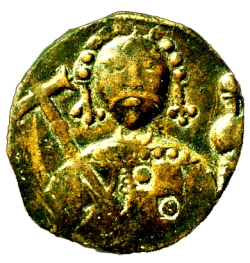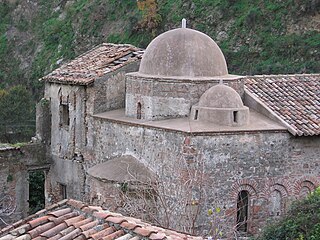Related Research Articles

Robert Guiscard, also referred to as Robert de Hauteville, was a Norman adventurer remembered for his conquest of southern Italy and Sicily in the 11th century.

Roger I, nicknamed "Roger Bosso" and "Grand Count Roger", was a Norman nobleman who became the first Grand Count of Sicily from 1071 to 1101.

Tancred of Hauteville was an 11th-century Norman petty lord. Little is known about him, and he is best remembered by the achievements of his twelve sons. Various legends arose about Tancred, but they have no supporting contemporary evidence that has survived the ages.

William of Hauteville, better known with his nickname, William Iron Arm, was a Norman military leader and the first Count of Apulia. He initiated the series of fortunes of the House of Hauteville.

Drogo of Hauteville was the second Norman Count of Apulia.

Humphrey of Hauteville, surnamed Abagelard, was the count of Apulia and Calabria from 1051 to his death.
Serlo of Hauteville was a son of Tancred of Hauteville by his first wife Muriella. Unlike his brothers, who left for Southern Italy, Serlo remained in Normandy and inherited his father’s possessions.
GaufredoMalaterra was an eleventh-century Benedictine monk and historian, possibly of Norman origin. He travelled to the southern Italian peninsula, passing some time in Apulia before entering the monastery of Sant'Agata at Catania, on the isle of Sicily. Malaterra indicates that, prior to his arrival in Catania, he had spent an undefined period away from monastic life, in the worldly service of "Martha".
Serlo of Hauteville was the son and namesake of Serlo of Hauteville. He followed his uncle Roger in Southern Italy and fought in his wars.

Jordan of Hauteville was the eldest son and bastard of Roger I of Sicily. A fighter, he took part, from an early age, in the conquests of his father in Sicily.
Mauger of Hauteville was a younger son of Tancred of Hauteville by his second wife, Fressenda. He travelled to the Mezzogiorno with his brother William and his elder half-brother Geoffrey around 1053, though some sources indicate him coming later, c.1056.
William of Hauteville was one of the younger sons of Tancred of Hauteville by his second wife Fressenda. He is usually called Willermus instead of Wilelmus in Latin annals and so is often called Guillerm instead of Guillaume in French.
Geoffrey the Elder was an Italo-Norman nobleman. A nephew of Robert Guiscard through one of his sisters, he was the count of Conversano from 1072 and the lord of Brindisi and Nardò from 1070, until his death.
Geoffrey of Ragusa was a son of Roger I, Count of Sicily. He was likely illegitimate. It is not possible for this Geoffrey to be the same as his brother, also named Geoffrey, as this other Geoffrey was born by Roger I’s first or second marriage and is recorded as being a leper by Goffredo Malaterra. In 1091, Geoffrey was granted the County of Ragusa by his father.

The House of Hauteville was a Norman family, originally of petty lords, from the Cotentin Peninsula in Normandy.

The Italo-Normans, or Siculo-Normans (Siculo-Normanni) when referring to Sicily and Southern Italy, are the Italian-born descendants of the first Norman conquerors to travel to Southern Italy in the first half of the eleventh century. While maintaining much of their distinctly Norman piety and customs of war, they were shaped by the diversity of Southern Italy, by the cultures and customs of the Greeks, Lombards, and Arabs in Sicily.

The Norman conquest of southern Italy lasted from 999 to 1194, involving many battles and independent conquerors.
The noble House of the Sarlo descends directly from Serlo I of Hauteville, son of Tancred de Hauteville and his first wife Muriella. Sarlo the first had a son from his marriage with the daughter of the Lord of Pirou also called Sarlo. Sarlo II went in the Mezzogiorno with his uncles to seek fortune.

The Battle of Cerami was fought in June 1063 and was one of the most significant battles in the Norman conquest of Sicily, 1060–1091. The battle was fought between a Norman expeditionary force and a Muslim alliance of Sicilian and Zirid troops. The Normans fought under the command of Roger de Hauteville, the youngest son of Tancred of Hauteville and brother of Robert Guiscard. The Muslim alliance consisted of the native Sicilian Muslims under the Kalbid ruling class of Palermo, led by Ibn al-Hawas, and Zirid reinforcements from North Africa led by the two princes, Ayyub and 'Ali. The battle was a resounding Norman victory that utterly routed the opposing force, causing divisions amongst the Muslim aristocracy which ultimately paved the way for the eventual capture of the Sicilian capital, Palermo, by the Normans and subsequently the rest of the island.
Fressenda was an 11th-century Norman noblewoman and the wife of Tancred of Hauteville. She is known as the mother of Robert Guiscard and Roger I of Sicily.
References
- 1 2 3 "SICILY". fmg.ac. Retrieved 2024-10-22.
- ↑ Houts, Elisabeth M. C. Van (2000-12-15). The Normans in Europe. Manchester University Press. ISBN 978-0-7190-4751-0.
- 1 2 "ALTAVILLA, Goffredo d' - Enciclopedia". Treccani (in Italian). Retrieved 2024-10-25.
- 1 2 Malaterra, Goffredo. The Deeds of Count Roger of Calabria and Sicily and of Duke Robert Guiscard his brother (PDF).
- ↑ "Breve Chronicon Northmannicum - Wikisource". la.wikisource.org (in Latin). Retrieved 2024-10-25.
- ↑ Teatro genologico delle famiglie nobili titolate feudatarie ed antiche nobili del fidelissimo Regno di Sicilia viuenti ed estinte. Del s. don Filadelfo Mugnos. Parte prima [-terza]. . (in Italian). nella stamparia di Giacomo Mattei. 1670.
- ↑ Annuario della nobiltà italiana (in Italian). Presso la direzione del Giornale araldico. 1878.
- ↑ Summonte, Giovanni Antonio (1748). Historia della cittá e regno di Napoli ... (in Italian). R. Gessari.
- ↑ Ebner, Pietro (1979). Economia e società nel Cilento medievale (in Italian). Ed. di Storia e Letteratura.